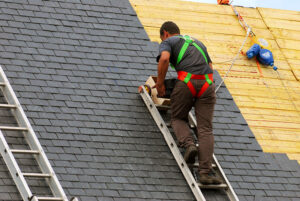Roofing is the process of protecting the roof of a building from the elements. It involves the use of metals, wood, and other materials. It also includes the use of nails, ice and water barriers, and roll-roofing. Choosing the right roofing material can be a big decision. Fortunately, there are a few options available to you.

Wood for roofing is one of the most popular materials on the market today. Its elegant appearance and versatility make it a great choice for your home.
The best type of wood for a roofing system is cedar. This is straight timber that is highly resistant to extreme weather conditions. It also has insulating properties that help keep your home warm and cool.
Particle board is another option for roofing. It is not real wood chopped from a tree, but it can be a good substitute. It is often sold in 4×8 sheets. However, it has its downsides.
It can be difficult to install, and it is susceptible to warping and moisture damage. It also doesn’t have a long lifespan. It isn’t recommended for roofs in colder climates.
Cedar can be enhanced to make it more resistant to fire and fungus growth. It’s also a natural element-proof wood that protects your home from outside humidity.
Wallaba is another roofing material that is popular for its natural resistance to bugs, mold, and fire. It’s also known for its resins. These resins repel bugs and corrosion.
Both cedar and teak wood are great options for a roofing system. Each has its own benefits. For instance, cedar shingles are resistant to moss and shrinkage. And teak is an exotic hardwood that creates a dense and durable roofing material.
It’s always best to match the color of your shingles to the color of your home. This will ensure that the color stays intact. It’s also a regular maintenance practice to stain the shingles to maintain their color.
Choosing the right metal for your roof is based on a number of factors. These include location, strains, and stresses. Then, the type of panel is determined.
Generally, residential metal roofing is made of copper or steel. These materials are durable and long-lasting. In fact, most of them have a lifetime of 50 years or more.
They are also fire-resistant. This makes them perfect for homes located in areas that are susceptible to wildfires. They can also be sound-proofed.
In addition to protecting your home from the elements, metal roofing is a green material. Its reflective pigment technology helps to reduce cooling and heating costs by up to 40%. It is also 100% recyclable.
There are a variety of colors and finishes to choose from. They can imitate slate, clay, or wood. They are also highly resistant to mildew, rot, and insects. In addition, they are low maintenance and cost-effective.
Several insurance companies offer reduced rates to homeowners who have a metal roof. However, it’s important to calculate your unique roofing costs before making a decision.
In addition, metal roofs are less likely to be damaged by hail. Large hailstones are known to ruin asphalt shingle roofs. But dime-sized hail rarely affects metal roofs.
While there are a variety of pros and cons to each of the types of metal, it’s best to find out which one is right for your home. It’s important to find an experienced roofing professional to install your new roof. They can guide you through the process and help you decide which type of metal is right for your home.
If you’re thinking of installing a metal roof, check with your local building authority for more information on the materials available. They may have information on the warranty and longevity of each type.
Unlike other roofing materials, roll roofing is very easy to install. It is also very light, making it easy to transport. However, it is not for every roof. It is recommended to use this type of roofing only on low-slope structures.
It is best to consult with a professional before installing a new roof. You should also check with your HOA about rules and regulations. Some HOAs do not like roll roofing. It does not offer a high resale value, and it will not last very long.
Before you begin to install your new roll roofing, you need to prepare the underlying material. You will need to remove any existing roofing material. This will prevent it from puncturing the rolled roofing. You may need to cut a hole in the roll for plumbing vents. You may also need to add boot flashing to keep the roll secure.